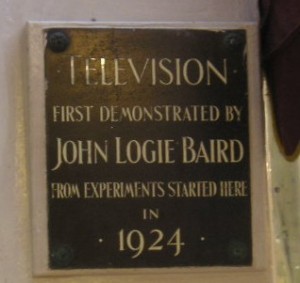
Television has always been an important part of my life – it has been my best friend. It has educated me, it has entertained me and it has even helped me keep time. When I was in primary school, I would know I was running late for school when a certain cartoon finished its scheduled episode.
In year nine, at a public speaking contest, my answer to the impromptu question ‘what, in your mind, is one of the most valuable inventions in history?’ was a two minute speech on the greatness of television.
Before reality TV and sitcoms, before half-naked vampires and burlesque fairies, Big Brother, The Simpsons and a television set in almost every home, television was a novelty that needed to prove itself. In acknowledgement that this new media had potential and a future, the BBC produced three experimental television broadcasts from its basement studio of Broadcasting House . The first of these broadcasts hit television screens 80 years ago today, only ten years after the formation of the BBC itself.
Using John Logie Baird’s 30-line mechanical television broadcast system, first demonstrated in Baird’s lab in 1924, Eustace Robb produced a television program. According to the BBC, ‘it was able to bring musicians and dancers to the tiny audience of “lookers-in” (as early viewers were known), as well as demonstrations of ju-jitsu, a performing sea lion, art, and fashion.’ It was also said that it was the best transmission that the 30-line system’s creator, Baird, had ever seen.
Despite the success of these transmissions, the 30-line mechanical system was eventually overtaken by electronic broadcast systems. However, these experimental broadcasts paved the way for the television we enjoy today. It led to the introduction of the world’s first regular high-definition service as well as the notion that television could provide more than providing a simple novelty; it could bring entertainment as well as information to a wide and engaged audience.
Today, television has shifted from images created by 30 grey scale lines on a fuzzy screen to the ability to see the sweat beading on an athlete’s skin in bright colours or even in 3D. British television models have also proved pivotal in the advancement of television in Australia as it is their digital television system that freeview is built upon. However, the most recent discussions on the future of television don’t look to traditional broadcast models but rather online, to the internet.
A recent Nielsen survey has suggested that online video consumption has risen considerably across all age groups. The survey found that while traditional television audience numbers remain high, more and more people are turning to the internet to get their video fix – and why shouldn’t they?
In Australia, international content is often delayed in reaching our screens with most programs broadcast almost a week after they are aired in their nation of origin. As the world becomes increasingly smaller with the internet connecting people and brands across the world at the click of a button, it is difficult for audiences to avoid the temptation to go online to get their fix of shows minutes after they have finished airing internationally, or to prevent the risk of spoilers. A friend of mine was so sick of spoilers that she unfollowed the Twitter feed of a favourite show of hers because their tweets continued to recap pivotal plot points of episodes that had already aired in the US days prior but were yet to air in Australia.
While the internet may cause some problems, it also provides solutions. The convergence of technologies that see digital content broadcast on our television screens also allows for seamless and relatively easy transmission of the content online for catch up and even preview. In the days prior to the premiere of Puberty Blues, Network Ten gave Facebook fans the opportunity to watch the first episode of the show online before it went to air on television. In addition to this, short video clips available to online audiences known as ‘web-only mini episodes’ or ‘webisodes’, keep audiences hooked onto a program in between seasons or before a show has even begun. These online campaigns bring audiences back to traditional media and ensure that audiences don’t forget about their favourite shows when they aren’t on the air.
The BBC is in a period of celebrating many milestones, from the 90th anniversary of the company’s formation this year, to the 50th anniversary of Doctor Who early next year. Eighty years on from its first experimental television broadcast, it is clear that television has come a long way and continues to prove its place in the modern world as both entertainer and educator.
Chani Unger is a third-year Bachelor of Journalism student at La Trobe University and is one of upstart’s staff writers. You can follow her on Twitter: @chaniunger






